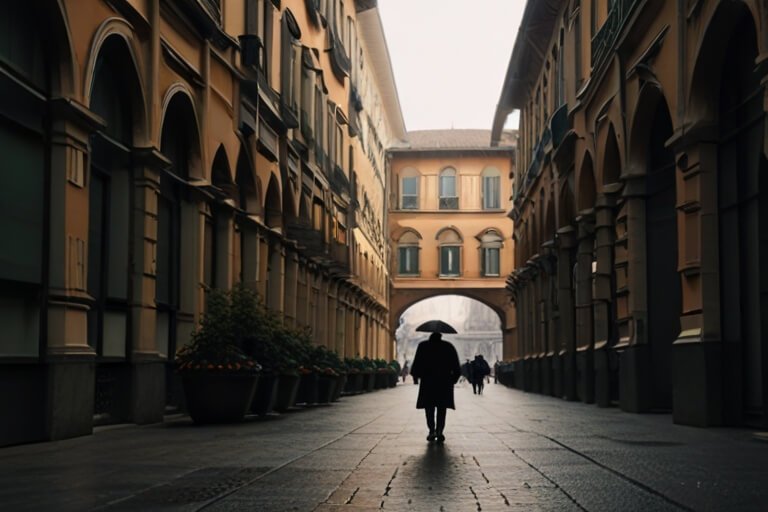How Many Days Do You Need in Northern Italy? A Comprehensive Guide
When it comes to planning a trip to Italy, the northern region offers a rich tapestry of history, culture, and natural beauty. From the romantic canals of Venice to the rolling hills of Tuscany, there’s something for every traveler. But how many days do you really need to explore Northern Italy? In this article, we’ll break down the must-see destinations, provide sample itineraries, and offer practical tips to make the most of your time in this enchanting part of the country.
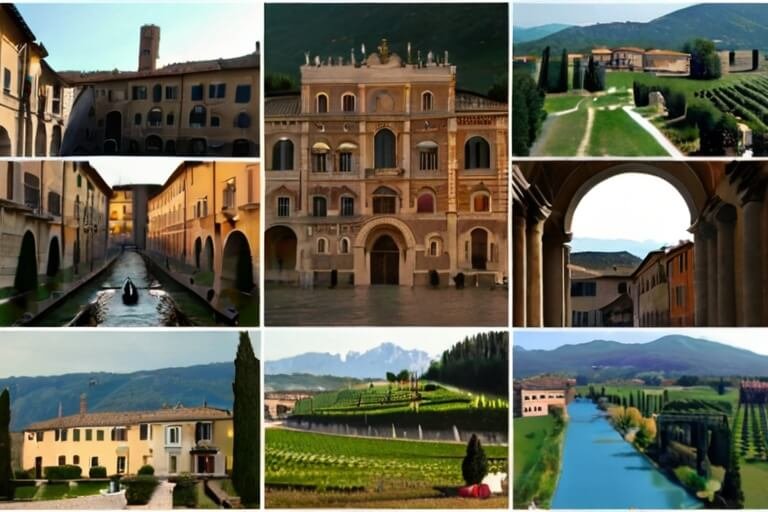
Picture this: You’re strolling along the cobblestone streets of Venice, the scent of freshly baked pastries lingering in the air. The sun dips below the horizon, casting a warm glow on the Grand Canal. Around you, gondolas glide gracefully, their gondoliers serenading passengers with melodic tunes. Welcome to Northern Italy, where every corner whispers tales of history, romance, and culinary delights.
But here’s the burning question: How many days do you need to truly savor the magic of this enchanting region? Is it a whirlwind weekend affair or a leisurely week-long exploration? Fear not, fellow traveler, for we’re about to unravel the secrets of Northern Italy’s treasures. Whether you’re drawn to the art-filled galleries of Florence, the vineyard-dotted hills of Tuscany, or the fashion-forward streets of Milan, we’ve got you covered.**
In this article, we’ll be your compass, guiding you through the labyrinth of choices. We’ll consider your interests, the must-see destinations, and the practical aspects of planning your Italian escapade. So grab your gelato (because, trust us, you’ll want some), and let’s embark on a journey that blends culture, cuisine, and captivating landscapes.
Why Northern Italy?
Northern Italy is a captivating blend of old-world charm and modern sophistication. Here are a few reasons why it should be on your travel radar:
- Art and Architecture: Milan, Florence, and Venice are home to some of the world’s most iconic art and architecture. From Leonardo da Vinci’s “The Last Supper” in Milan to Michelangelo’s David in Florence, you’ll be surrounded by masterpieces.
- Culinary Delights: Northern Italy is a food lover’s paradise. Indulge in creamy risottos, fresh seafood, and delectable pastries. Don’t miss out on the famous gelato!
- Scenic Landscapes: The Italian Lakes (Lake Como, Lake Garda, and Lake Maggiore) offer stunning vistas. Drive through the vineyards of Piedmont or hike in the Dolomites for breathtaking views.
- Historical Cities: Verona, Bologna, and Turin are steeped in history. Explore ancient Roman ruins, medieval castles, and charming piazzas.
Sample Itineraries
1. Venice and the Venetian Islands (3-4 Days)
- Day 1: Explore the canals of Venice, visit St. Mark’s Basilica, and take a gondola ride.
- Day 2: Hop over to Murano for glass-blowing demonstrations and Burano for colorful houses.
- Day 3: Discover the lesser-known islands like Torcello and Lido.
2. Milan and Lake Como (4-5 Days)
- Day 1: Admire Milan’s Gothic Cathedral (Il Duomo) and shop on Via Montenapoleone.
- Day 2: Take a day trip to Lake Como, visit Villa del Balbianello, and enjoy the scenic beauty.
- Day 3: Explore Leonardo da Vinci’s “The Last Supper” and the trendy Navigli district.
3. Florence and Tuscany (5-7 Days)
- Day 1: Marvel at Florence’s Uffizi Gallery and Ponte Vecchio.
- Day 2: Drive through the Tuscan countryside, stopping in Siena and San Gimignano.
- Day 3-7: Explore the Chianti wine region, visit Pisa, and relax in the thermal baths of Montecatini Terme.
Practical Tips
- Transportation: Consider a rail pass for seamless travel between cities. Trains are efficient and scenic.
- Accommodation: Stay centrally to maximize your time. Look for boutique hotels or charming B&Bs.
- Local Cuisine: Try regional specialties like risotto alla Milanese, tagliatelle al ragù, and tiramisu.
- Weather: Spring (April to June) and fall (September to October) are ideal for pleasant weather and fewer crowds.
Key Takeaways : How many days do you need in Northern Italy?
| Destination | Ideal Duration | Highlights |
|---|---|---|
| Venice and Islands | 3-4 days | Canals, St. Mark’s Basilica, Murano glass, gondola rides |
| Milan and Lake Como | 4-5 days | Milan Cathedral, Lake Como, Villa del Balbianello, Navigli district |
| Florence and Tuscany | 5-7 days | Uffizi Gallery, Tuscan countryside, Chianti wine region, Pisa, Montecatini Terme thermal baths |
READ MORE:
IS 10 DAYS ENOUGH TIME TO VISIT ITALY? : UNVEILING YOUR SPECTACULAR ADVENTURE
Day 1: Arriving in Milan
As the wheels of your plane touch down on Milan’s tarmac, you’re greeted by an electric buzz—the kind that only Italy’s fashion capital can deliver. The air smells of espresso and anticipation. Your adventure begins.
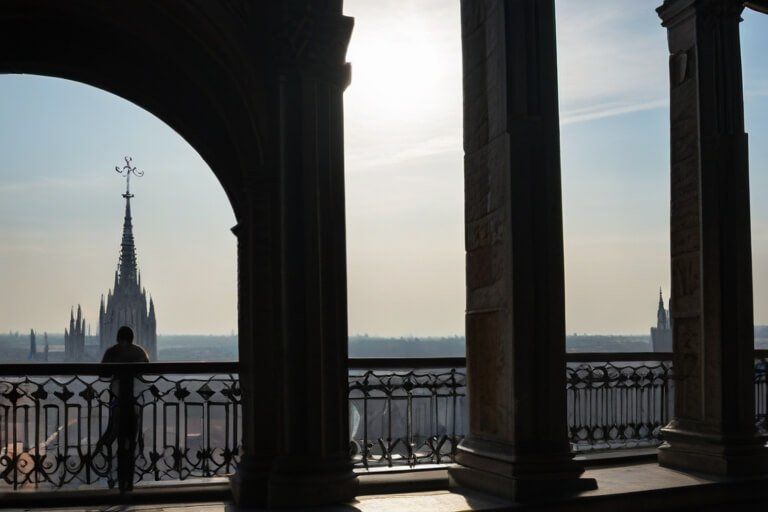
Morning: Milan Cathedral and Rooftop Views
- Milan Cathedral (Il Duomo): Leave your luggage at a chic boutique hotel—think minimalist design, plush linens, and a hint of Italian flair. But don’t linger too long; the Duomo di Milano awaits. Its marble facade, adorned with spires and statues, is a testament to Gothic grandeur. Ascend the narrow staircase or take the elevator (your choice) to the rooftop. Here, the city unfolds before you—a patchwork of terracotta rooftops, bustling piazzas, and distant mountains. Snap photos, breathe in the history, and feel the heartbeat of Milan.
Afternoon: Via Montenapoleone and Espresso Breaks
- Via Montenapoleone: The name alone sounds like a melody. This is where luxury whispers in silk and cashmere. Stroll along this elegant street, flanked by designer boutiques. Chanel, Prada, Gucci—they’re all here, beckoning you to step inside. Even if your budget doesn’t allow for a shopping spree, soak in the ambiance. Pause at a sidewalk café, order an espresso, and people-watch. Milanese fashionistas glide past, their sunglasses perched just so. You’re part of the scene now.
Evening: Navigli—Where Canals and Creativity Collide
- Navigli District: As the sun dips low, follow the scent of pizza and the sound of laughter. The Navigli district is your canvas—a place where canals intersect, and creativity flows. Wander along the Naviglio Grande, its waters reflecting the colors of sunset. Art galleries spill their secrets, and vintage shops beckon with hidden treasures. Find a trattoria tucked away in a cobblestone alley. Order a plate of risotto alla Milanese—the saffron-infused rice is a symphony of flavor. Sip a glass of local wine, and let the evening unfold. Maybe there’s live jazz tonight, or perhaps a pop-up art exhibit. Milan keeps its surprises close.
Day 2: Lake Como Extravaganza
As the sun rises over Milan, you’re already on the move. Today, Lake Como awaits—a shimmering jewel nestled in the embrace of the Alps. It’s a place where time slows down, and every view feels like a canvas.
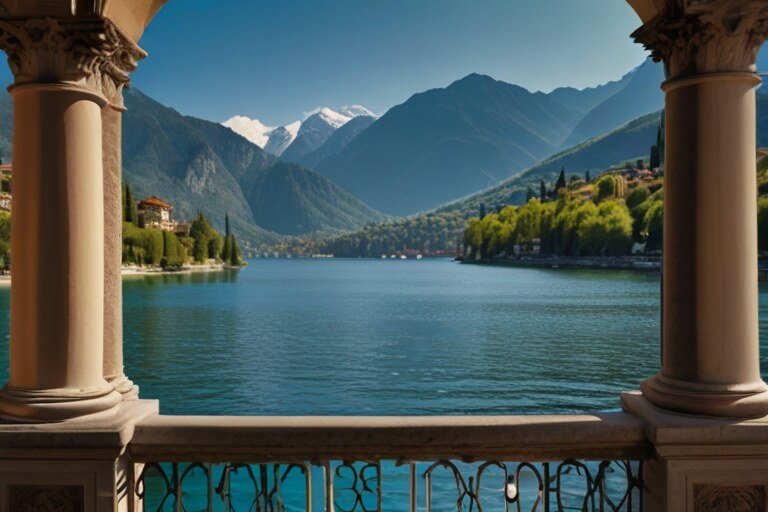
Morning: All Aboard to Como
- Train to Como: The rhythmic clatter of wheels on tracks lulls you as you board the train. The journey from Milan to Como is a mere hour, but it’s a journey through landscapes that shift like scenes from an old Italian film. Rolling hills, vineyards, and glimpses of distant lakes—it’s a prelude to the grandeur awaiting you.
- Charming Como: Stepping off the train, you’re greeted by the scent of cypress trees and the distant hum of boat engines. Como, with its pastel-colored buildings and cobblestone streets, feels like a warm embrace. Drop your bags at a cozy inn—perhaps one with a balcony overlooking the lake—and set out to explore.
Afternoon: Villa del Balbianello—A Fairytale Retreat
- Boat Ride Across the Lake: The water laps against the wooden dock as you step onto a waiting boat. Lake Como stretches out before you, its surface like liquid silver. The boat glides smoothly, and you watch the shoreline unfold—the opulent villas, each with its story. George Clooney’s villa winks from a distant point, a secret whispered among locals.
- Villa del Balbianello: The boat docks at Lenno, and you follow a winding path through lush gardens. And there it stands: Villa del Balbianello. Imagine a fairytale castle, its terraces cascading down to the water. Stone archways frame views of the lake, and you half-expect to see Cinderella step out in her glass slippers. But no, this villa has a different tale—it was James Bond’s hideaway in “Casino Royale.” You channel your inner 007 as you explore the terraces, imagining secret meetings and high-stakes poker games.
Evening: Dinner by the Water’s Edge
- Lakeside Dinner: As the sun dips below the mountains, you find yourself at a lakeside restaurant. The tables spill onto a wooden deck, and fairy lights twinkle overhead. The menu is a symphony of flavors—freshly caught fish, risotto kissed by saffron, and a tiramisu that melts on your tongue. You sip local wine, and the lights across the lake begin to dance. It’s a scene from a postcard—one you’ll tuck into your heart forever.
Day 3: Venice—City of Canals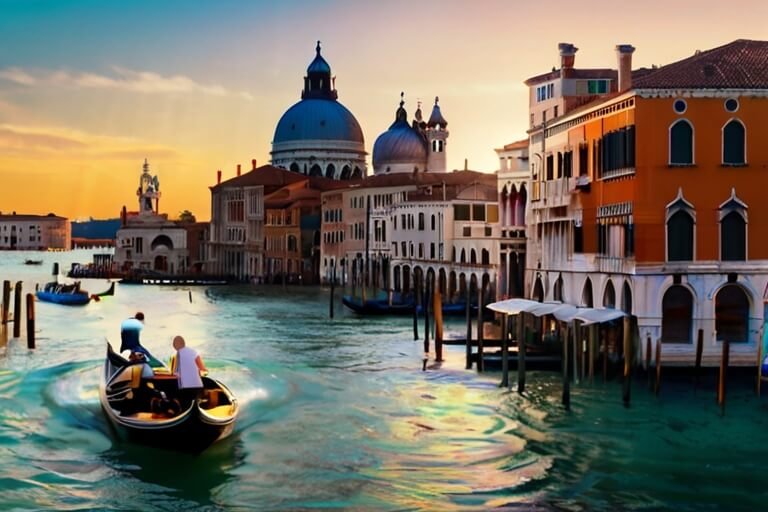
As the train glides into Venice, you’re greeted by a symphony of water and whispers. This is no ordinary city—it’s a floating masterpiece, where every alley holds secrets and every bridge leads to enchantment.
Morning: Arriving in Venice
- High-Speed Train: The journey from Milan to Venice is swift, but it feels like stepping into a different era. The train whisks you across the Venetian lagoon, and suddenly, there it is—the City of Canals. You disembark at Santa Lucia Station, and the scent of saltwater mingles with the aroma of freshly baked pastries. Your cozy inn awaits, nestled near the Grand Canal. The water taxis bob, and gondoliers in striped shirts beckon. Drop your bags, and let the adventure begin.
Afternoon: St. Mark’s Square and Basilica
- St. Mark’s Square (Piazza San Marco): The heart of Venice, where pigeons pirouette and history hangs heavy. The St. Mark’s Basilica stands like a jewel box, its Byzantine domes adorned with mosaics that tell tales of saints and emperors. Step inside—the golden light, the hushed whispers—it’s a sanctuary frozen in time. Climb the Campanile for a bird’s-eye view of the square. The rooftops stretch to infinity, and the lagoon shimmers beyond.
- Gondola Ride: You can’t visit Venice without gliding along its watery veins. Find a gondola, preferably one with a singing gondolier. Lean back, let the serenade wash over you, and watch the palazzos drift by. The Rialto Bridge arches overhead, and you catch glimpses of masked revelers disappearing into narrow alleys. Venice is a maze, but getting lost here is a privilege.
Evening: Prosecco and Sunset
- Canal-Side Dinner: As the sun paints the sky in hues of apricot and rose, choose a canal-side restaurant. Tables spill onto terraces, their legs dipping into the water. Order a glass of chilled Prosecco—it sparkles like the lagoon itself. The menu offers seafood risotto, bruschetta with fresh tomatoes, and tiramisu that tastes like whispered promises. The gondolas glide past, their lanterns flickering. You raise your glass to Venice—the city that defies logic, where marble palaces rise from the sea, and love stories are etched in every stone.
Day 4: Island Hopping in the Venetian Lagoon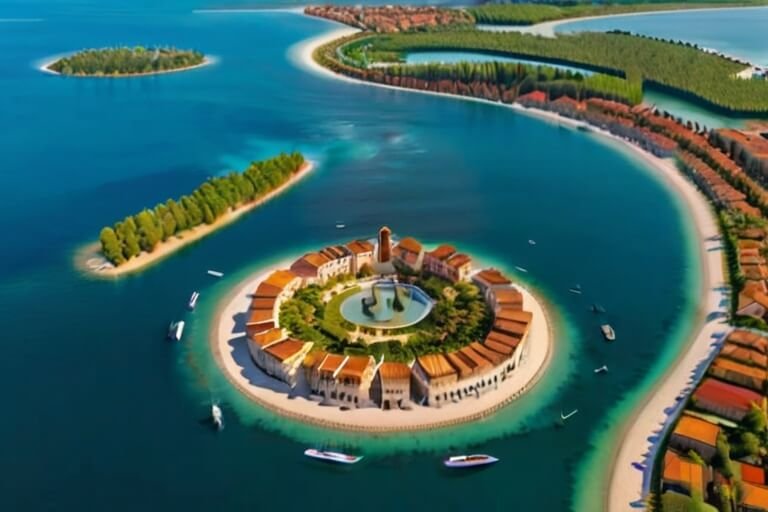
As the sun rises over Venice, you’re ready for a day of exploration beyond the city’s labyrinthine streets. Today, it’s all about the islands—their vibrant colors, their whispered stories.
Morning: Murano—Where Glass Comes Alive
- Vaporetto to Murano: The vaporetto glides across the lagoon, leaving Venice’s palazzos behind. Murano awaits—a place where glass-blowing is an art form passed down through generations. Step onto the island, and the air crackles with creativity. The glass factories beckon, their furnaces roaring. Watch artisans transform molten blobs into delicate chandeliers, intricate vases, and whimsical sculptures. The glass sparkles—cobalt blues, fiery reds, and translucent greens. You’ll want to take a piece of Murano home with you.
Afternoon: Burano—A Rainbow of Houses
- Colorful Houses: Another vaporetto ride, and you arrive at Burano. It’s as if a painter spilled their palette here. Houses stand shoulder to shoulder, each flaunting a different hue. The blues are bluer, the yellows sunnier. You’re in a postcard come to life. Wander the narrow streets, your camera clicking. The laundry flutters from windows, and the scent of fresh pasta wafts from trattorias. Find the leaning tower—the one that rivals Pisa—and snap an Instagram-worthy photo. Burano is a place where time dances to its own tune.
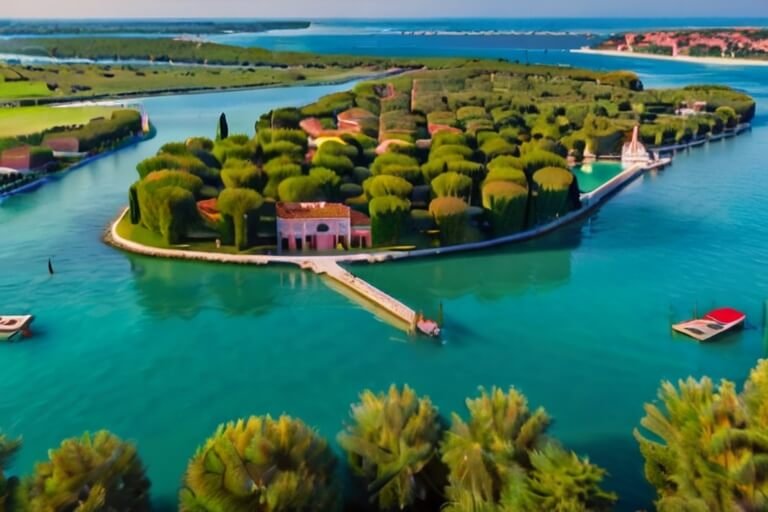
Evening: Seafood by the Water
- Return to Venice: As the sun dips low, the vaporetto carries you back to Venice. The Grand Canal welcomes you, its palazzos winking in the twilight. You’re hungry, and Venice knows how to satisfy. Find a canal-side restaurant—the kind where the tables almost touch the water. Order a seafood feast—clams, mussels, calamari—all kissed by the salt breeze. The wine flows, and the gondolas glide past, their gondoliers singing softly. It’s a symphony of flavors and reflections. You raise your glass to the islands—their secrets, their colors, their magic.
Day 5: Florence—Art and History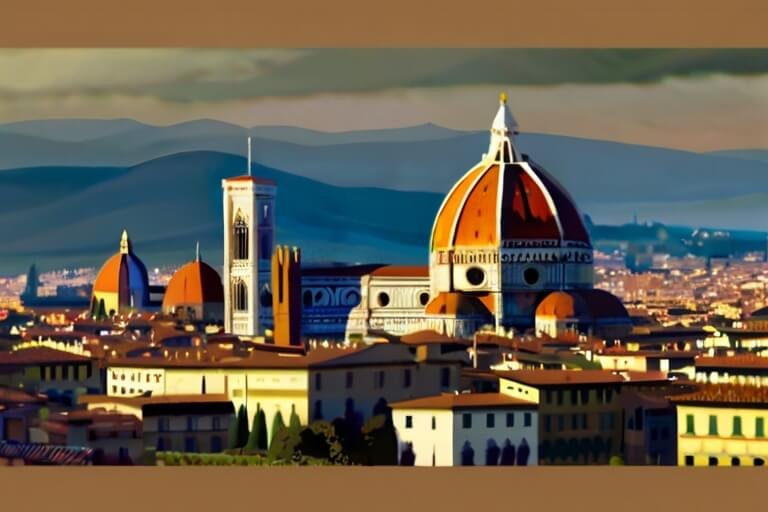
As the train glides through the Tuscan countryside, you feel the pulse of history. Florence awaits—a city that birthed the Renaissance, where every cobblestone whispers secrets of art, intellect, and passion.
Morning: Uffizi Gallery and Botticelli’s Masterpiece
- Uffizi Gallery: The grand doors of the Uffizi Gallery swing open, and you step into a treasure trove. The air smells of centuries-old canvas, and the walls hold stories. Room after room, you’re surrounded by masterpieces—Leonardo da Vinci, Raphael, and Michelangelo. But today, your eyes seek out Sandro Botticelli. His brush danced across canvas, capturing myths, allegories, and the very essence of Florence.
- The Birth of Venus: There she is—the goddess herself. Venus, born from the sea foam, blown by the west wind, Zephyr. Her hair cascades like golden waves, and her skin glows like alabaster. She stands on a shell, modestly covering her private parts. On her left, the winds caress her, showering roses. On her right, a handmaid waits, ready to dress her in a flowered mantle. This is The Birth of Venus, painted between 1482 and 1485. It’s a hymn to love, beauty, and the Neoplatonic ideals that swirled in the Medici court. The canvas itself is a marvel—Botticelli dared to paint on it, using alabaster powder to make colors timeless. And here, in the Uffizi, it hangs—a beacon of grace and longing.
Afternoon: Ponte Vecchio and the Oltrarno
- Ponte Vecchio: Cross the Ponte Vecchio, the bridge that spans the Arno River. It’s not just any bridge—it’s a gallery. Jewelers’ shops line its sides, their windows gleaming with gold, silver, and gemstones. As you walk, imagine the Medicis strolling here, their cloaks billowing. The bridge has seen wars, floods, and lovers’ trysts. Pause in the middle, lean against the railing, and watch the river flow. Florence unfolds—the red-tiled roofs, the hills beyond, and the promise of more art around every corner.
- Oltrarno District: Venture beyond the tourist trails. Cross the river, and you’re in the Oltrarno—the other side. Here, artisans ply their trade—leatherworkers, bookbinders, and woodcarvers. The streets narrow, the buildings lean. Find the Brancacci Chapel—Masaccio’s frescoes will stop you in your tracks. The colors are still vivid, the faces haunting. Wander deeper, and you’ll stumble upon hidden courtyards, where jasmine spills over stone walls. The Oltrarno is Florence’s soul—the imperfect, the authentic.
Evening: Trattoria Delights
- Dinner at a Trattoria: The sun dips low, casting a warm glow on the cobblestones. Find a trattoria—a family-run eatery where the menu sings of tradition. Order tagliatelle al ragù—ribbons of pasta coated in slow-cooked meat sauce. The wine flows, and the conversation hums. The trattoria walls hold memories—of laughter, of whispered confessions. You’re part of this tapestry now. Savor every bite, every sip. The night wraps around you, and Florence whispers, “Stay a little longer.”
Day 6-7: Tuscan Countryside—Where Time Slows and Hills Roll
As the sun rises over Florence, you trade the city’s cobblestones for the open road. The Tuscan countryside awaits—a canvas of vineyards, olive groves, and sun-kissed hills. Buckle up, fellow traveler, for this is where dreams are woven.
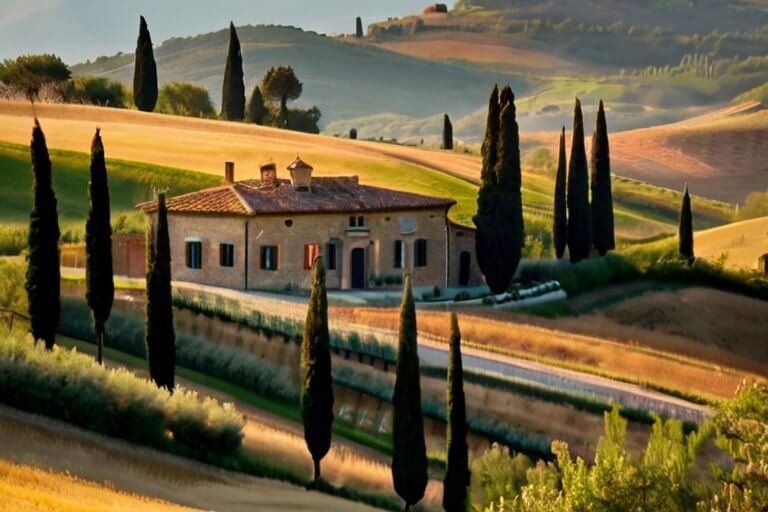
Day 6: Siena—Medieval Splendor
- Morning: Rent a Car: The engine purrs as you slip behind the wheel. The GPS blinks, and you’re off—the wind in your hair, the scent of cypress trees in the air. The Tuscan roads curve like a lover’s embrace, and soon, you arrive in Siena. This city wears its medieval heart on its sleeve. The Piazza del Campo beckons—a shell-shaped square where horses once raced. The Palazzo Pubblico stands tall, its tower reaching for the sky. Climb it—the view is a symphony of terracotta rooftops and rolling hills. Siena’s cathedral—the Duomo di Siena—awaits. Its facade is a kaleidoscope of marble, and inside, you’ll find masterpieces by Michelangelo, Donatello, and Pinturicchio. Siena is a time capsule—a place where history whispers in every stone.
- Afternoon: San Gimignano—Towers to the Sky
- San Gimignano: The road winds, and suddenly, you’re in a fairy tale. San Gimignano—a hilltop town crowned with towers. Fourteen of them remain, like sentinels guarding secrets. Climb the Torre Grossa—the tallest—and let the panorama steal your breath. The Tuscan hills stretch to infinity, and the vineyards below promise wine that tastes of sunshine. Wander the cobbled streets, peek into artisan shops, and find a gelateria. The gelato here is poetry—each flavor a sonnet. San Gimignano is a place where time slows, where you can lose yourself in the golden light.
Day 7: Chianti—Wine and Starlight
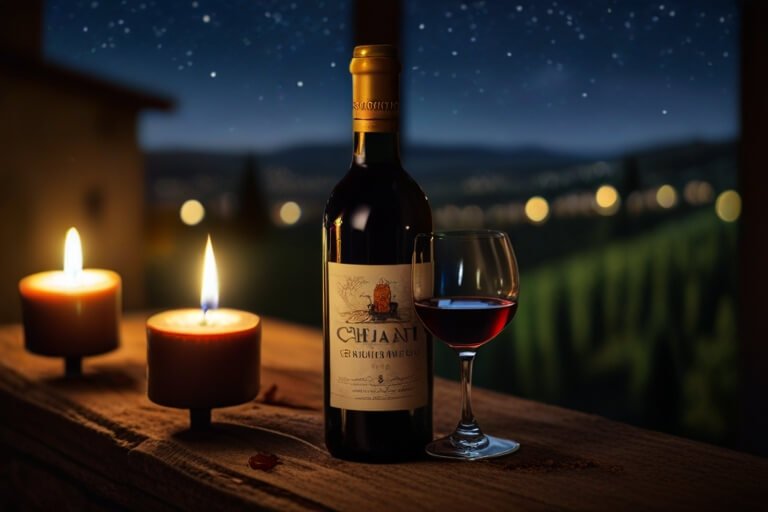
- Morning: Drive to Chianti: The road twists, and suddenly, you’re in the heart of Chianti. Vineyards stretch like green oceans, their rows orderly, their grapes plump with promise. Rent a villa—a rustic farmhouse with wooden shutters and a view that belongs in a Renaissance painting. The air smells of earth and anticipation. Chianti is wine country, and you’re about to sip liquid poetry. The Chianti Classico flows—a ruby elixir that warms your soul. Visit a winery—meet the vintner, touch the barrels, and taste the nectar. The sun filters through grape leaves, and you’re in love.
- Evening: Under the Stars
- Dining Alfresco: As the sun dips low, set a table under the pergola. The stars emerge—one by one—as if the universe knows you’re here. The wine glasses clink, and the fireflies dance. Dinner arrives—ribollita, bistecca alla fiorentina, and a crusty loaf of bread. The olive oil is liquid gold, and the cheese—aged and crumbly—is a love letter to Tuscany. You sip, you savor, and you listen. The cicadas sing, and the night wraps around you. Chianti is more than wine—it’s communion with the land, with the stars, with the very essence of life.





